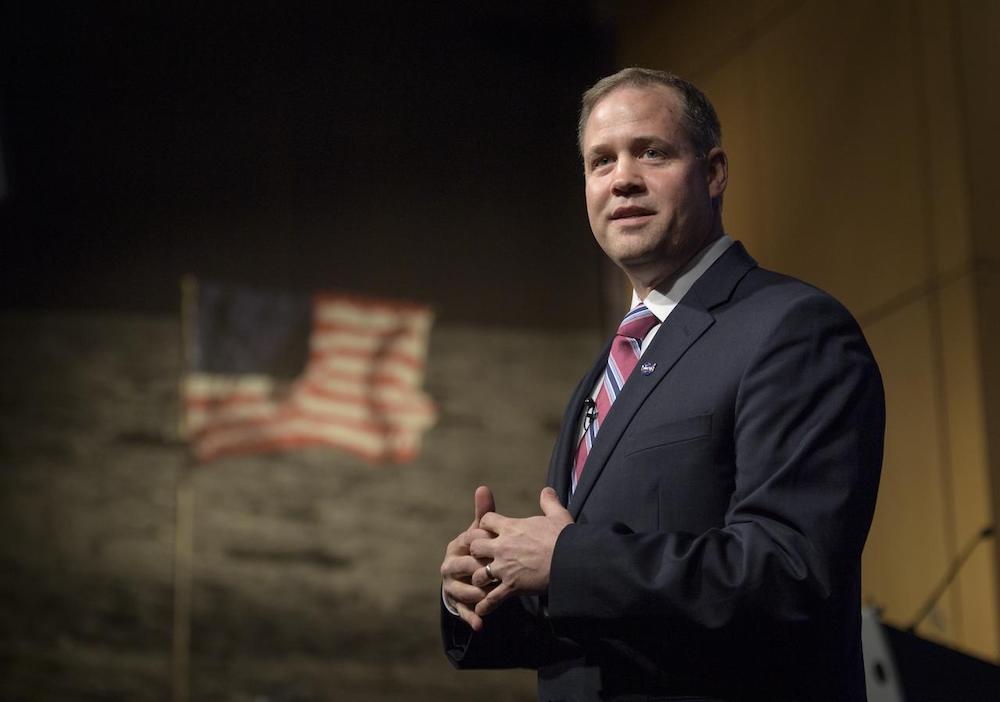Head Of NASA Jim Bridenstine Answers Your Questions
The NASA administrator discusses everything from Mars to the Space Force.

NASA Administrator Jim Bridenstine has a lot to say. On a recent appearance on Science Friday, he spoke about his views on climate change, the organization’s continued commitment to the Space Launch System, and how plant science relates to NASA. But there were still many questions that you wanted answered, so Science Friday sent some of your questions to Bridenstine. Here’s what he said.
Answers have been edited for clarity and/or length.
Going forward, what is the plan to handle the difficulties associated with what seems to be an increasing level of hesitancy toward believing NASA-backed scientific consensus? (In other words, some people choose to believe the world is flat. How do we address this and more?)
— Lewis Lopez (@PeacefulPagoda) March 8, 2019
Jim Bridenstine: NASA remains committed to studying our home planet with more than 20 Earth-observing satellite missions and major instruments, and more than a dozen in the pipeline. NASA freely shares this knowledge and works with institutions worldwide to gain new insights into how our planet is changing.
Does NASA have any interest in crowdsourcing? The Library of Congress @librarycongress uses it for transcription of text in images, and Geohive @teamGeoHIVE uses it for disaster relief. Could NASA use this tool to promote #STEM interest within the education community?
— Rochelle_T (@ai_rochelle) March 7, 2019
Jim Bridenstine: NASA has been involved in crowdsourcing for a number of years. In fact, data from NASA’s planet-finding Kepler spacecraft led to the first multi-planet system discovered entirely through crowdsourcing!
From David on Facebook:
What do you think will be the next major achievement in crewed exploration, and when do you think we’ll do it?
Jim Bridenstine: We will go to the Moon in the next decade in a way we have never gone before. We will go with innovative new technologies and systems to explore more locations across the surface than was ever thought possible. This time, when we go to the Moon, we will stay. And then we will use what we learn on the Moon to take the next giant leap—sending astronauts to Mars.
I’ve been thinking, I’ve a few [1]: Why has Oklahoma never had a @NASA Facility / Laboratory outside of University connected ones. In Muskogee as a kid was hoping we would get the wind tunnel in my town. But nothing came up anywhere in @JimBridenstine ‘s home state.
— daniel yount (@icarusfactor) March 7, 2019
Jim Bridenstine: Even without a dedicated facility in the great state of Oklahoma, NASA’s work with partner organizations in the state helps improve people’s lives across the globe. Here are some of the ways we’re in our home state: http://spacegrant.oknasa.org/ http://epscor.oknasa.org/
From Heather On Facebook:
How do you feel about Space Force?
Jim Bridenstine: For more than 60 years, NASA has led the world in the peaceful uses of outer space. We are a civilian agency dedicated to science, exploration, and discovery. Our mission will continue in partnership with other nations, and we’ll remain separate from any military branch of the government. We also recognize that space is vital to the well-being of the world and is essential to many aspects of our daily lives including communications, navigation, weather prediction, food and energy production, banking, and so much more. Our civilization depends on space being safe and accessible, and it’s critical to protect our interests in space, including NASA spacecraft and the International Space Station. We look forward to learning more about the Space Force as the Defense Department begins implementing Space Policy Directive-4.
From Muhammad On Facebook:
I am interested to know if there are any plans to land a probe on Europa and search for extraterrestrial life? Perhaps NASA is waiting for Clipper to provide more detailed imaging and radar data to understand what lies beneath the ice sheet?
Jim Bridenstine: NASA’s cutting-edge Europa Clipper mission to fly by Jupiter’s icy moon is a first step in exploring ocean worlds and their potential habitability. As complicated as sending a spacecraft to fly by Europa is, landing on it is even more challenging, so a lot of work needs to be done before we take that particular plunge.
Invest in quality science journalism by making a donation to Science Friday.
Johanna Mayer is a podcast producer and hosted Science Diction from Science Friday. When she’s not working, she’s probably baking a fruit pie. Cherry’s her specialty, but she whips up a mean rhubarb streusel as well.
Christopher Intagliata was Science Friday’s senior producer. He once served as a prop in an optical illusion and speaks passable Ira Flatowese.